2. 结构工程灾变与控制教育部重点实验室(哈尔滨工业大学),哈尔滨 150090;
3. 土木工程智能防灾减灾工业和信息化部重点实验室(哈尔滨工业大学),哈尔滨 150090
2. Key Lab of Structures Dynamic Behavior and Control (Harbin Institute of Technology), Ministry of Education, Harbin 150090, China;
3. Key Lab of Smart Prevention and Mitigation of Civil Engineering Disasters (Harbin Institute of Technology), Ministry of Industry and Information Technology, Harbin 150090, China
粒化高炉矿渣(简称矿渣)是冶炼生铁过程中经过水淬急冷得到的不规则玻璃体[1],其主要成分为硅铝酸盐[2],具有潜在活性[1].目前中国每年产出矿渣数亿吨,其中仅有20%~30%用作混凝土矿物掺合料,其余的均被当成固体废弃物闲置[3].以磨细的高炉矿渣粉为主要原料,通过碱性激发剂(如水玻璃)激发,经搅拌可制成碱激发矿渣胶凝材料(alkali-activated slag cementitious material,简称AASCM)[4-6].AASCM能够充分利用工业废渣[7],且省去了制备水泥所需的“两磨一烧”的繁琐工艺,显著减小混凝土材料对于环境的影响,大大降低了温室气体排放量及能源需求量[8-11].
AASCM具有高强、快硬、耐久等优点[12-16],但在成型过程中AASCM收缩较大、易开裂,这大大减小了其在工程上的应用范围[17-18].考虑加入不存在收缩的陶粒和陶砂配制成碱激发矿渣陶粒混凝土,这样势必对于抑制它的收缩具有显著效果[19].由于AASCM净浆经历600 ℃高温后,其抗压强度基本不降低[4],而陶粒和陶砂经高温烧制形成,具有相对较好的隔热性能和耐火性能[20-21],因此碱激发矿渣陶粒混凝土的耐高温性能似较普通混凝土好.
在混凝土砌块高温后力学性能研究方面,Ayala等[22]对历经200、400、600和800 ℃的普通混凝土砌块高温后力学性能进行了试验.试验结果表明,历经200~800 ℃高温后普通混凝土砌块抗压强度较常温下降低18%~65%.在碱激发矿渣普通骨料混凝土的高温后力学性能研究方面,国内外学者[23-26]多认为碱激发矿渣混凝土的耐高温性能相对于普通水泥混凝土要好些.
鉴于对高温后碱激发矿渣陶粒混凝土砌块受压力学性能研究尚属空白,本文对MU10和MU20两个强度等级的碱激发矿渣陶粒混凝土砌块进行了高温后受压力学性能试验,探索了碱激发矿渣陶粒混凝土砌块高温后抗压强度随历经温度的变化规律.
1 原材料与试验方法 1.1 原材料矿渣:试验选用两种矿渣:1)S95级的哈尔滨矿渣,比表面积为463 m2/kg,由哈尔滨三发新型节能建材有限责任公司提供;2)S105级的唐山矿渣,比表面积为550 m2/kg,由唐山铁兰公司提供.两种矿渣的化学成分和各项活性指标,分别见表 1、2.
| 表 1 矿渣的化学成分 Tab. 1 Chemical constituents of slag |
| 表 2 矿渣的活性指标 Tab. 2 Activity indexes of slag |
陶砂:试验选用的陶砂为巩义市超越滤料厂生产的粉煤灰陶砂,粒度1mm,圆度≥0.9,其化学成分见表 3.
| 表 3 陶砂的化学成分 Tab. 3 Chemical constituents of pottery sand |
陶粒:试验选用3种陶粒:1)由郑州市宇轩环保公司提供的粒径为5~10 mm的粉煤灰陶粒;2)由巩义市超越滤料厂提供的粒径为5~10 mm的瓷砂陶粒;3)由巩义市超越滤料厂提供的粒径为10~16 mm的瓷砂陶粒.3种陶粒的物理力学性能见表 4.
| 表 4 陶粒物理力学性能 Tab. 4 Physical and mechanical properties of ceramsite |
水玻璃:选用钠水玻璃,由河北省永清县聚利得化工有限公司生产,相关技术指标见表 5.
| 表 5 钠水玻璃的技术指标 Tab. 5 Technical indexes of Na2O·nSiO2 |
氢氧化钠:采用天津市大陆化学试剂厂生产的颗粒状分析纯氢氧化钠,质量分数≥96.0%.
无水碳酸钠:采用天津市致远化学试剂有限公司生产的粉末状分析纯无水碳酸钠,质量分数≥99.8%.
1.2 试验方法 1.2.1 试件制作MU10和MU20两个强度等级的碱激发矿渣陶粒混凝土砌块配合比分别见表 6.采用拼装式混凝土砌块模具制备碱激发矿渣陶粒混凝土砌块.该模具由有机玻璃制成,包括4块侧板、1块底板、1块盖板和2个内芯:4块侧板由4根M6螺杆连接成整体,侧板和内芯通过M6螺栓和配套螺母与底板连接.模具实物见图 1.碱激发矿渣陶粒混凝土砌块尺寸为390 mm×190 mm×190 mm,具体尺寸见图 2.选取400、600、700、800、900、1 000和1 100 ℃这7个温度作为加热温度,常温20 ℃的试件作为对比件,每个强度等级的砌块每个温度均各3个试件,因此共需制作48个陶粒混凝土砌块.MU10、MU20两个强度等级作为对比件的试块见图 3.将制作好的试块置于标准养护室中至其强度稳定.

|
图 1 模具实物图 Fig. 1 Physical map of the mould |
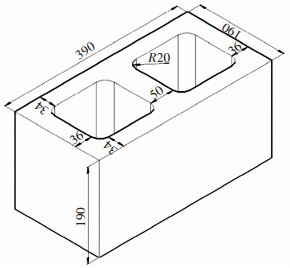
|
图 2 砌块尺寸(mm) Fig. 2 Dimensional drawing of the blocks (mm) |
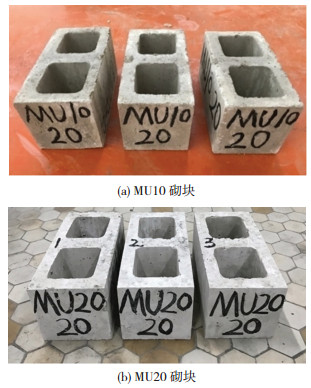
|
图 3 作对比件用碱激发矿渣陶粒混凝土砌块 Fig. 3 Alkali-activated slag ceramsite concrete blocks used as a contrast |
| 表 6 碱激发矿渣陶粒混凝土砌块的配合比 Tab. 6 Mix proportions of alkali-activated slag ceramiste concrete blocks |
使用额定功率22 kW的高温节能箱式电炉对试块进行高温试验,采取三阶段升温制度:第一阶段,以10 ℃/min的速度由室温升至300 ℃;第二阶段,以4 ℃/min的速度由300 ℃升至目标温度;第三阶段,达到目标温度后,恒温2 h以保证试件内部温度与炉温趋于一致.升温曲线见图 4.加热完成后,关闭箱式电炉加热电源,当炉内温度降至300 ℃时,打开炉门;当炉内温度降至50 ℃时,取出试块.这里需要强调指出,ISO834标准升温曲线早期升温速率高,升温30 min环境温度即达841 ℃,这样高的升温速率会使碱激发矿渣陶粒混凝土试块发生高温爆裂,故本文采用的升温制度与ISO834升温曲线不同.

|
图 4 升温曲线 Fig. 4 Heating curve |
依据GB/T 4111—2013《混凝土砌块和砖试验方法》[27],使用高强石膏对砌块的上下表面进行抹平.抹平后用5 000 kN微机屏显液压压力试验机对砌块进行高温后抗压试验,采用力加载控制,加载速率为4~6 kN/s.试验过程见图 5.
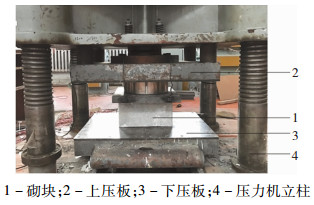
|
图 5 砌块高温后抗压试验 Fig. 5 Compression tests after the block′s exposure to high temperature |
随着历经温度的升高,高温后MU10试块颜色经历了浅灰色、暗红色、深灰色、亮白色、深褐色等多个阶段,历经各温度后试块形态见图 6(a).随着历经温度的升高,高温后MU20试块颜色经历了亮白色、红褐色、亮黄色、黄褐色等多个阶段,历经各温度后试块形态见图 6(b).
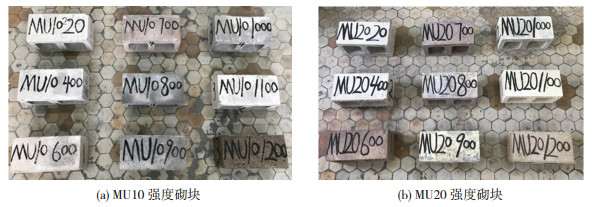
|
图 6 两个强度砌块历经各温度后的形态 Fig. 6 Appearance morphology of blocks for two strength grades after exposure to different temperatures |
MU10和MU20两个强度等级砌块的高温后抗压强度见表 7.
| 表 7 两个强度等级砌块的高温后抗压强度 Tab. 7 Compressive strengths of blocks after exposure to high temperatures for two strength grades |
令θ为历经温度,fB.θ为历经温度θ作用后砌块的抗压强度,fB为常温(20 ℃)时砌块的抗压强度.以θ为横坐标,以历经温度θ作用后砌块抗压强度相对值fB.θ/ fB为纵坐标建立坐标系,将历经不同温度的高温后砌块抗压强度试验结果布置于该坐标系中.对各试验点进行拟合,可得图 7所示线性拟合曲线.
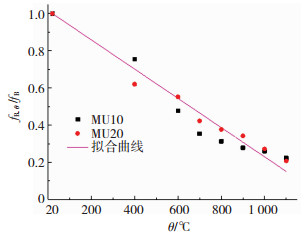
|
图 7 砌块高温后抗压强度的拟合情况 Fig. 7 Fitting of compressive strengths of blocks after exposure to high temperatures |
与拟合曲线相对应的高温后碱激发矿渣陶粒混凝土砌块抗压强度相对值计算公式为
| $\begin{array}{l} \frac{{{f_{{\rm{B}}, \theta }}}}{{{f_{\rm{B}}}}} = 1.00 - 0.79\left( {\frac{{\theta - 20}}{{1000}}} \right), \\ 20{\rm{℃}} \le \theta \le 1100{\rm{℃}}, {R^2} = 0.952, \end{array} $ |
式中R2为表征拟合精度的相关系数.
4 结论1) 碱激发矿渣陶粒混凝土砌块在历经温度介于20~1 100 ℃时,高温后抗压强度随历经温度的增高而线性降低.
2) 建立了高温后碱激发矿渣陶粒混凝土砌块抗压强度相对值随历经温度变化的计算公式.
| [1] |
陈慧娟. 碱激发矿渣水泥混凝土的试验研究[J]. 建筑技术开发, 1997(1): 21. CHEN Huijuan. Experimental study on alkali-activated slag concrete[J]. Building Technique Development, 1997(1): 21. |
| [2] |
沈宝镜.碱激发矿渣水泥抗海水侵蚀性能的研究[D].西安: 西安建筑科技大学, 2011 SHEN Baojing.Study on the performance of alkali-activated slag cement under seawater corrosion[D].Xi′an: Xi′an University of Architecture and Technology, 2011 |
| [3] |
PUERTAS F, MARTIÍNEZ-RAMIÍREZ S, ALONSO S, et al. Alkali-activated fly ash/slag cements:strength behaviour and hydration products[J]. Cement&Concrete Research, 2000, 30(10): 1625. DOI:10.1016/S0008-8846(00)00298-2 |
| [4] |
郑文忠, 朱晶. 碱矿渣胶凝材料结构工程应用基础[M]. 哈尔滨: 哈尔滨工业大学出版社, 2015: 2. ZHENG Wenzhong, ZHU Jing. Application foundation of alkali-activated slag cementitious material in structural engineering[M]. Harbin: Harbin Institute of Technology Press, 2015: 2. |
| [5] |
FREIDIN C. Alkali-activated cement based on natural SiO2-containing material[J]. Cement&Concrete Research, 2003, 33(9): 1417. DOI:10.1016/S0008-8846(03)00088-7 |
| [6] |
郑文忠, 陈伟宏, 王英. 碱矿渣胶凝材料的耐高温性能[J]. 华中科技大学学报(自然科学版), 2009(10): 96. ZHENG Wenzhong, CHEN Weihong, WANG Ying. High-temperature resistance performance of alkali-activated slag cementitious materials[J]. Journal of Huazhong University of Science and Technology (Natural Science Edition), 2009(10): 96. DOI:10.13245/j.hust.2009.10.014 |
| [7] |
程臻赟. 碱矿渣水泥混凝土的抗渗性能试验研究[J]. 硅酸盐通报, 2014, 33(11): 2963. CHENG Zhenyun. Experimental study on impermeability of alkali activated slag concrete[J]. Bulletin of the Chinese Ceramic Society, 2014, 33(11): 2963. DOI:10.16552/j.cnki.issn1001-1625.2014.11.052 |
| [8] |
JIANG M, CHEN X, RAJABIPOUR F, et al. Comparative life cycle assessment of conventional, glass powder, and alkali-activated slag concrete and mortar[J]. Journal of Infrastructure Systems, 2014, 20(4): 401. DOI:10.1061/(ASCE)IS.1943-555X.0000211 |
| [9] |
宋开伟, 石从黎, 罗晖, 等. 碱矿渣水泥体积收缩的控制方法[J]. 混凝土, 2011(5): 57. SONG Kaiwei, SHI Congli, LUO Hui, et al. Regulation of shrinkage of the alkali-activated cement[J]. Concrete, 2011(5): 57. DOI:10.3969/j.issn.1002-3550.2011.05.020 |
| [10] |
KUMAR S, GARCÍA-TRIÑANES P, TEIXEIRA-PINTO A, et al. Development of alkali-activated cement from mechanically activated silico-manganese (SiMn) slag[J]. Cement&Concrete Composites, 2013, 40(10): 7. DOI:10.1016/j.cemconcomp.2013.03.026 |
| [11] |
张俊, 丛钢, 杨长辉. 偏高岭土对碱矿渣水泥砂浆干缩性能的影响[J]. 混凝土, 2010(10): 115. ZHANG Jun, CONG Gang, YANG Changhui. Effect of metakaolin on dry-shrinkage of alkali-activated slag cement mortar[J]. Concrete, 2010(10): 115. |
| [12] |
史才军, 巴维尔·克利文科, 黛拉·罗伊, 等. 碱-激发水泥和混凝土[M]. 北京: 化学工业出版社, 2008: 103. SHI Caijun, KRIVENKO P V, ROY D, et al. Alkali-activated cements and concretes[M]. Beijing: Chemical Industry Press, 2008: 103. |
| [13] |
PALOMO A, MACLAS A, BLANCO M T, et al.Physical chemical and mechanical characterisation of geopolymer[C]//Proceedings of the 9th International Congress on the Chemistry of Cement.New Delhi: National Council for Cement and Building Materials, 1992: 508
|
| [14] |
王聪.碱激发胶凝材料的性能研究[D].哈尔滨: 哈尔滨工业大学, 2006 WANG Cong.Performance research on alkali-activated coagulation materials[D].Harbin: Harbin Institute of Technology, 2006 |
| [15] |
王爱国, 孙道胜, 胡普华, 等. 碱激发偏高岭土制备土聚水泥的试验研究[J]. 合肥工业大学学报, 2008(4): 617. WANG Aiguo, SUN Daosheng, Hu Puhua, et al. Experimental research on preparing geopolymeric cement with metakaolin activated by alkali activators[J]. Journal of Hefei University of Technology, 2008(4): 617. DOI:10.3969/j.issn.1003-5060.2008.04.031 |
| [16] |
王玉江, 李和平, 任和平. 土聚水泥的研究[J]. 硅酸盐通报, 2003(4): 70. WANG Yujiang, LI Heping, REN Heping. Study on geopolymeric cement[J]. Bulletin of the Chinese Ceramic Society, 2003(4): 70. DOI:10.16552/j.cnki.issn1001-1625.2003.04.016 |
| [17] |
JIAO Zhenzhen, WANG Ying, ZHENG Wenzhong, et al. Effect of dosage of sodium carbonate on the strength and drying shrinkage of sodium hydroxide based alkali-activated slag paste[J]. Construction and Building Materials, 2018, 179: 17. DOI:10.1016/j.conbuildmat.2018.05.194 |
| [18] |
程可佳.碱矿渣陶粒混凝土的自收缩及抗裂性能研究[D].福州: 福州大学, 2016 CHENG Kejia.Study on autogenous shrinkage and crack resistance of alkali-activated slag ceramsite concrete[D].Fuzhou: Fuzhou University, 2016 |
| [19] |
郑文忠, 黄文宣, 焦贞贞, 等. 碱矿渣陶粒混凝土基本性能试验研究[J]. 北京工业大学学报, 2017, 43(8): 1183. ZHENG Wenzhong, HUANG Wenxuan, JIAO Zhenzhen, et al. Experiment research on basic performance of alkali-activated slag ceramsite concrete[J]. Journal of Beijing University of Technology, 2017, 43(8): 1183. |
| [20] |
刘本刚. 耐高温轻质陶粒混凝土的配合比设计及应用[J]. 混凝土, 2015(11): 157. LIU Bengang. Mix design and application of high temperature resistant lightweight aggregate concrete[J]. Concrete, 2015(11): 157. DOI:10.3969/j.issn.1002-3550.2015.11.042 |
| [21] |
孙庆霞.纤维增强陶粒混凝土耐高温性能的实验研究[D].兰州: 兰州理工大学, 2009 SUN Qingxia.The experimental research on fiber reinforced ceramsite concrete about high temperature performance[D].Lanzhou: Lanzhou University of Technology, 2009 |
| [22] |
AYALA F R, BAILEY C G. Mechanical properties and structural behaviour of masonry at elevated temperatures[J]. Physical Review C, 2011, 75(6): 422. |
| [23] |
傅博.碱矿渣混凝土耐高温性能研究[D].重庆: 重庆大学, 2014 FU Bo.Research on properties of alkali slag concrete subjected to elevated temperatures[D].Chongqing: Chongqing University, 2014 |
| [24] |
AYDIN S, BARADAN B. High temperature resistance of alkali-activated slag-and portland cement-based reactive powder concrete[J]. Aci Materials Journal, 2012, 109(4): 469. |
| [25] |
张海燕, 祁术亮, 曹亮. 地聚物净浆、砂浆和混凝土高温后力学性能比较[J]. 防灾减灾工程学报, 2015(1): 15. ZHANG Haiyan, QI Shuliang, CAO Liang. Mechanical performance comparison of geopolymer paste, mortar and concrete after exposure to high temperature[J]. Journal of Disaster Prevention and Mitigation Engineering, 2015(1): 15. DOI:10.13409/j.cnki.jdpme.2015.01.003 |
| [26] |
CHI M C, HUANG R, LU W H. Strength and resistance of alkali-activated slag concrete to high temperature[J]. Applied Mechanics&Materials, 2012, 193. DOI:10.4028/www.scientific.net/AMM.193-194.431 |
| [27] |
混凝土砌块和砖试验方法: GB/T 4111-2013[S].北京: 中国标准出版社, 2013 Test methods for the concrete block and brick: GB/T 4111-2013[S].Beijing: Standards Press of China, 2013 |
 2019, Vol. 6
2019, Vol. 6


